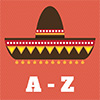 Traditional pieces of the male and female national costumes in Mexico: baja jacket, caites, charros, charro suit, china poblana, chincuete, cowboy boots, enagua, enredo, faja, guayabero, huaraches, huipil, mecapal, moral, pointy boots, poncho, posahuanco, rebozo, refajo, sarape, sombrero, tzute, quechquémitl.
Traditional pieces of the male and female national costumes in Mexico: baja jacket, caites, charros, charro suit, china poblana, chincuete, cowboy boots, enagua, enredo, faja, guayabero, huaraches, huipil, mecapal, moral, pointy boots, poncho, posahuanco, rebozo, refajo, sarape, sombrero, tzute, quechquémitl.
Baja jacket (baja hoodie, baja sweatshirt) – Mexican hooded shirt which is very popular among Mexican and American youth. Mostly men wear it, but women sometimes also do. Baja jacket usually is rather warm, it has a hood and a large pocket situated on the belly. This jacket is often colorful, with striped pattern.
Caites – ancient Mexican shoes, a variation of sandals. They consisted of a hard sole, a back part, and a leather lacing.
Charros (Charro-style shoes) – cowboy boots used with a Charro suit. This footwear is shorter and has fewer decorations than the classic cowboy boots.
Charro suit – special beautifully embroidered and decorated attire worn by Mexican cowboys. It is not a single piece of clothing but the whole set which consists of a ruffled shirt, tight-fitting trousers, a short jacket, cowboy boots, and a sombrero hat. This costume is often worn on the Day of the Dead (famous Mexican holiday).
China poblana – traditional costume used in central and southeastern regions of Mexico until the end of the 19th century. It is not a single piece of clothing but the whole set which consists of an undergarment, a blouse, a wide skirt, a belt, a shawl, shoes, and optional kerchief or scarf.
Chincuete – pleated Mexican female skirt used in some regions of the country. It is ankle-length and tied at the waist with a sash.
Cowboy boots – leather boots (often exotic animal skin is used – armadillo, bull, ostrich, lizard) traditionally used by Mexican cowboys but today worn by anybody. They can be high-heeled or flat-heeled, with high or low boot-top. Mexican cowboy boots usually have narrow pointed toes.
Enagua – traditional Mexican women’s skirt used in some regions of the country.
Enredo – woven wrap-around skirt made from wool. It is worn by Mexican females in some regions of the country. The same as “posahuanco”.
Faja – colorful woven sash used in Mexico. Usually, there are different traditional patterns woven into the fabric.
Guayabero (guayabera) – lightweight men’s shirt used both as a casual and formal dress. It is made of cotton and typically worn untucked. The distinctive feature of a guayabera is two vertical rows of closely sewn pleats, embroidery, or braiding.
Huaraches – traditional handmade leather sandals. These are the most common shoes in Mexico. Nowadays, not only leather is used to make huaraches – different synthetic materials often replace the animal skin.
Huipil – traditional female loose-fitting sleeveless tunic made from cotton or wool. It is worn with a skirt, though, the length of the garment varies from waist-length to floor-length. Huipil is one of the most popular women's clothing in Mexico. In most cases, it is richly decorated with embroidery, lace, ribbons, etc.
Mecapal (mecapalli) – special strap used to carry goods in an unusual way. For centuries, Mexicans had used it before replacing it with a modern backpack. The macapal is connected to the luggage (sack, basket, furniture, etc.) and placed on top of the head. Such a way of carrying involves the spine rather than shoulders. The macapal is made from leather, ixtle plant, or cotton. Another name for it is “tumpline”.
Moral – typical Mexican bag with shoulder strap. It is usually woven and decorated with the traditional patterns.
Pointy boots – rather unusual male boots with very narrow and elongated toe. Sometimes their toe is up to 1.5 meter (5 feet) long and curved up to the knees of a man. Usually, Mexican pointy boots are very colorful, often decorated with such elements as flashing LED lights, disco balls, and even mirrors. They are often worn by bands, singers, and dancers.
Poncho – traditional Mexican warm outerwear. It is a woven garment. There are many variations of a poncho design. For example, the classical poncho is a simple piece of cloth with a hole for the head; it doesn't have sleeves, but sometimes has a hood. Rainproof poncho is fitted with fasteners for the sides or has openings for the arms. It is more typical for men to wear a poncho, but some women use it, too. Also, poncho has several different regional names: pala, chamanto, ruana, gabán, jorongo, etc.
Posahuanco – woven wrap-around skirt made from wool. It is worn by Mexican females in some regions of the country. The same as “enredo”.
Rebozo – female shawl/scarf made from cotton, wool, or silk. The color and pattern of rebozo represent the region and community. This piece of Mexican traditional costume is used not only as clothes, but also to carry products and goods, even babies.
Refajo – traditional Mexican women’s skirt used in some regions of the country.
Sarape (serape) – large colorful shawl-like coat, often decorated with a fringe. It is usually worn by men. Sarape can serve as a shawl and also as a blanket – it is woven, and therefore, warm.
Sombrero – traditional and world-famous Mexican hat with a wide brim. This hat is made of straw or heavy felt; often embellished with embroidery, tiny pom-pons, ribbons, and colorful patterns. It protects the body from the sun, rain, etc.
Tzute – male hand-woven scarf worn around the head and over the shoulder. It can be used to carry goods.
Quechquémitl (quezquemitl) – shawl-like garment in Mexico since the pre-Hispanic period. It consists of two rectangular woven pieces of cloth sewn together.


